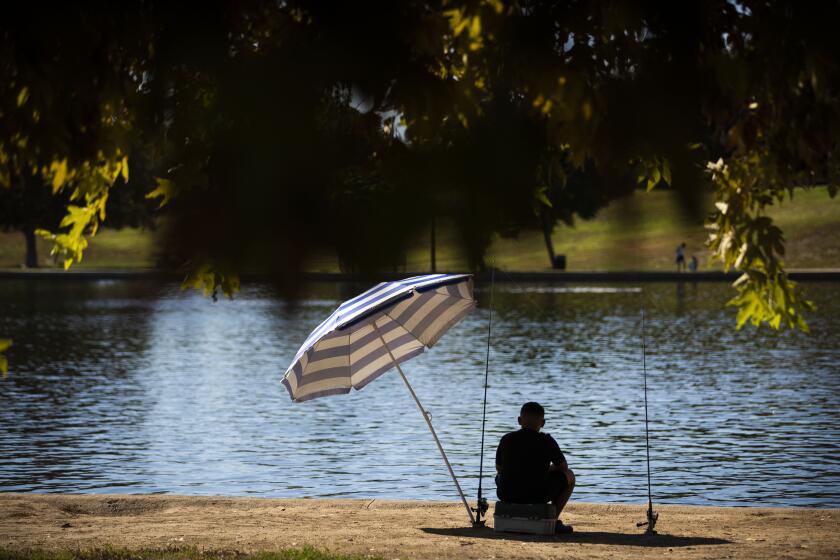Doctors treat thousands for heatstroke in southern Pakistan as temperatures hit 117

- Share via
KARACHI, Pakistan — A days-long intense heat wave has disrupted normal life in Pakistan, especially in its largest city, Karachi, where doctors treated thousands of victims of heatstroke at various hospitals, health officials said Tuesday.
Several people fell unconscious in the city and some of them later died, local media said.
Temperatures soared as high as 117 degrees in Sindh province on Tuesday. Authorities in Karachi, the provincial capital, are urging people to stay indoors, hydrate, and avoid unnecessary travel.
Weather forecasters say the heat wave, which began in May, will subside next week.
According to local media, the days-long heat wave also killed more than two dozen people in Karachi, but no government spokesman was available to confirm the number of heatstroke-related deaths.
On Tuesday, Faisal Edhi, the head of the Edhi Foundation, which runs the country’s largest ambulance service, said they received dozens of bodies of heatstroke victims in Karachi the previous day.
Saudi Health Minister Fahd bin Abdurrahman Al-Jalajel said 83% of the fatalities were unauthorized pilgrims who walked long distances in soaring heat.
Imran Sarwar Sheikh, the head of the emergency ward at the state-run Civil Hospital in Karachi, told the Associated Press that they treated 120 victims of heatstroke the previous day. Eight of those patients later died, he said.
On Monday, more than 1,500 victims of heatstroke were treated at other hospitals in the city, according to local media.
Sardar Sarfaraz, the chief meteorologist in Karachi, said temperatures will continue to rise this week across Pakistan. “Today, the weather is dry. In such conditions, the temperature starts rising,” he said.
Pakistan’s climate is warming much faster than the global average, with a potential rise of 2.3 to 8.8 degrees Fahrenheit by the 2090s over the 1986–2005 baseline, according to a World Bank expert panel on climate change.
Toward a more sustainable California
Get Boiling Point, our newsletter exploring climate change, energy and the environment, and become part of the conversation — and the solution.
You may occasionally receive promotional content from the Los Angeles Times.
The country, which is one of the most vulnerable in the world to climate change, also faces the risk of heavier monsoon rains, in part because of its immense northern glaciers, which are now melting as temperatures rise. Warmer air can hold more moisture, intensifying the monsoon.
This year’s monsoon will start in July, causing flash floods, according to a statement released by Pakistan’s National Disaster Management Authority. The warning from the agency comes less than two weeks after a top U.N. official said an estimated 200,000 people in Pakistan could be affected by the upcoming monsoon season.
Extreme heat will strain power grids and threaten millions more Americans by 2050, a new report has found.
However, officials say this year’s rains would not be as heavy as those in 2022 when devastating floods killed 1,739 people, destroyed 2 million homes, and covered as much as one-third of the country at one point.
The 2022 floods caused more than $30 billion in damage to Pakistan’s already cash-strapped economy.
Pakistan says despite contributing less than 1% to carbon emissions worldwide, it is bearing the brunt of global climate disasters.
The ongoing heat in recent months also had a large impact on agriculture, damaging crops and reducing yields, as well as on education, with school vacations having to be extended and schools closed in several countries, affecting thousands of students.
Climate experts say extreme heat in South Asia during the pre-monsoon season is becoming more frequent. The study found that extreme temperatures are now about 1.5 degrees hotter in the region because of climate change, and this year Pakistan witnessed above-normal rains and heat.
Farooq writes for the Associated Press.
More to Read
Sign up for Essential California
The most important California stories and recommendations in your inbox every morning.
You may occasionally receive promotional content from the Los Angeles Times.












